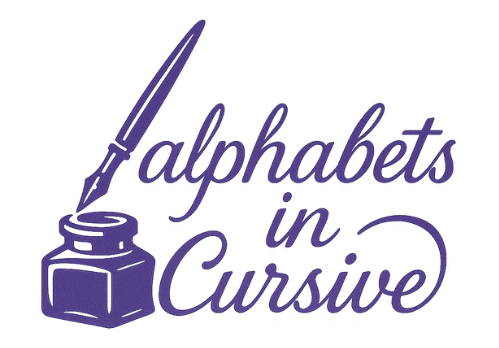Cursive B: How to Write Uppercase & Lowercase (with PDF Worksheets)
Cursive B can be a litle challenging due to its tall shape and multiple strokes, but with proper technique and regular practice, it becomes easy to master. This guide provides step-by-step instructions, helpful tips, common mistakes, and a daily practice downloadable worksheet to improve your cursive B writing skills.
Download Worksheets [PDF]
The worksheet is just one piece of the learning process. What matters most is how you use it. A few minutes of focused practice can build real progress. Help your child or students master the letter B in cursive writing with our free printable worksheets.
Click below to download and print your favorite worksheet.



Next Lesson: Cursive C
How to Write the Cursive Letter B
The letter B has a tall, strong shape in cursive. It stands out on the page and uses big, rounded strokes. You’ll need a steady hand and a little patience, but once you get the movement right, it feels smooth to write.
How to Write Lowercase Cursive b
Start on the bottom line. Make a straight stroke up to the top line, then bring it straight back down. From there, curve out to the right, loop around halfway up, and finish with a small tail that moves right.

Steps to follow:
- Start at the bottom line.
- Go straight up to the top line.
- Pull down the same line to the bottom.
- Curve out and make a small loop that comes back up to the midline.
- End with a right-moving tail to connect to the next letter.
Visual cue (described in words):
It looks like a tall stick with a belly like drawing the number 6 after a straight line.
Common Mistakes to Avoid While Practicing Lowercase Cursive “b”
While writing cursive “b”, learners often struggle with loop size, slant, and connections that affect the letter’s balance and flow. Being aware of these issues can help improve your writing style quickly.
Common Mistakes:
- Incorrect loop size: Making the upper loop too large or too small can make the letter look uneven.
- Flat or uneven slant: The letter should have a smooth rightward slant, not stand straight or lean too much.
- Disconnected strokes: Forgetting to connect the tail of “b” to the next letter breaks the flow.
- Uneven baseline: The lower curve should rest neatly on the line, not float or dip below it.
- Rushed strokes: Writing too fast can distort the loop, making it resemble “l” or “h.”

How to Write Uppercase Cursive B
This letter begins with a long upward stroke. After reaching the top line, you come back down, then make two loops one large at the top, one smaller at the bottom.

Steps to follow:
- Start at the bottom line.
- Move up in a straight line to the top.
- Pull down the same path.
- Curve out to make a large top loop.
- Then make a smaller loop just below it.
- End with a smooth finish stroke to the right.
Visual cue (described in words):
Think of it as a tall stick with two big bubbles stacked on the right side.
Take it slow at first. Focus on making the strokes steady and even. Don’t worry about speed yet that comes with practice.
Common Mistakes to Avoid While Practicing Uppercase Cursive “B”
When writing uppercase cursive “B”, many learners face issues with proportions and smoothness. Recognizing these common errors helps create a more elegant and consistent capital letter.
Common Mistakes:
- Uneven loops: The top and bottom loops should be balanced; one shouldn’t overpower the other.
- Wrong starting point: Beginning too high or low changes the letter’s height and shape.
- Overly straight or curved stem: The main stroke should have a gentle slant—not too upright or slanted.
- Disconnected loops: The top and bottom loops must connect fluidly without sharp corners.
- Inconsistent size: The capital “B” should be taller than lowercase letters but still match other uppercase letters.
- Writing too quickly: Rushing the strokes can make loops uneven and ruin the smooth cursive flow.

How to Connect Cursive B to Other Letters
Once you can write cursive B by itself, the next step is learning how it fits into words. The shape of lowercase b makes it easy to connect. Uppercase B is a bit different it usually stands on its own.

How to Connect Lowercase Cursive b
Lowercase b is built to connect. After you make the tall stroke and round belly, it ends with a smooth, right-slanting tail. That tail is the bridge to the next letter.
What to keep in mind:
- The tail should be short and light, not stretched or dragged.
- Don’t pause after finishing b — let your hand flow into the next letter.
- Keep your loop round. If it turns sharp, the word looks uneven.
Common letter pairs:
- ba – b flows into a with a soft curve. Think of it like a hill sliding into a circle.
- be – The curve of e catches the tail of b. Try not to lift the pencil.
- bi – After b, glide into i with a small upward hook.
- bo – The o begins right where b ends. Watch the spacing to keep the loop clean.
- bu – b and u follow the same slant, so they flow well when your hand stays relaxed.
Practice words Worksheet

Write each word slowly. Focus on the shapes, not the speed. Look for letters that lean the same way and check that your tails are connecting in the right spot just above the baseline.
How to Connect Uppercase Cursive B?
Uppercase B is different. It’s tall, round, and takes more space. It often starts a word and doesn’t always connect to the next letter especially in personal names or titles.
What to keep in mind:
- Most people lift the pencil after finishing the B, then start the next letter on its own.
- Some styles allow for a direct connection, but only when done neatly.
- If you connect, the final stroke of B should curve down and slightly right, ready to meet the next letter at the midline.
Example names:
- Ben – B is written fully, then e starts just beside it.
- Bella – You can either lift after B or glide into e. Both are correct, but it depends on your writing style.
- Brandon – B can connect softly into r if the ending stroke is placed right.
Practice tip:
Try both ways connecting and not connecting. See which one feels more natural and cleaner. For school writing, either is accepted as long as the word stays readable.
Practice Words with “b” (begin/middle/end)
Practicing words with the letter “b” in different positions helps improve your control and consistency when writing it in cursive. Here are some examples:
At the Beginning:
- ball
- bird
- bright
- butter
- baby
In the Middle:
- rabbit
- cabin
- table
- ribbon
- habit
At the End:
- cab
- job
- bulb
- club
- crab
Practice Methods for Writing Cursive B
Writing cursive B takes more movement than many other letters. It’s tall, has curves, and needs a steady pace. These methods help build control, shape memory, and writing flow.
1- Start with Finger Tracing
Before picking up a pencil, use your finger to trace the letter on paper, in the air, or on a table. This builds motion memory without pressure. For kids, this can be a game. For adults, it helps loosen the hand before writing.
Tip: Say the strokes out loud as you trace. Example: “up, down, loop, curve.”
2- Use the Right Pencil Grip and Paper Position
Good writing starts with how you hold the pencil and place the paper.
- Hold the pencil between your thumb and index finger. Let it rest on the middle finger.
- Keep your grip light. If your hand feels tight, loosen up.
- Tilt the paper slightly so your writing hand moves freely across the page.
- Sit straight and keep your wrist relaxed.
These small things make big changes in how smooth your writing feels.
3- Practice in Short Sessions
Writing a few strong letters is better than rushing through a whole page.
- Start with five uppercase B’s, then five lowercase b’s.
- Focus on each curve and stroke.
- Stop when your hand gets tired. That means it’s time to take a break, not push harder.
Over time, your hand will move with more ease and your letters will stay more even.
4- Look for Progress, Not Perfection
Not every letter needs to look the same. You’re learning a movement, not copying a shape. Circle the one you like best on each row. That becomes your personal guide for the next session.
Sentences That Use Cursive B
Now that you’ve practiced cursive B on its own, it’s time to use it in real words. This helps you get used to how B moves with other letters and builds a natural writing flow.
Now try short cursive sentences that use B. These help you learn spacing and keep your writing balanced.
Try these:
- Ben has a big blue bag.
- Bella baked bread.
- Bobby bumped into a box.
- The bell rang at the end.
- A bug bit my leg.
Write each sentence once, then again on a new line. On the second try, focus on keeping your size even and your slant steady.
Daily Cursive Practice Plan for Letter B
You don’t need long lessons to improve your writing. A few minutes a day, done right, will help your hand remember the strokes and feel of cursive B. This plan keeps things simple and builds your skill step by step.


One Comment